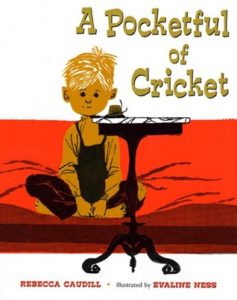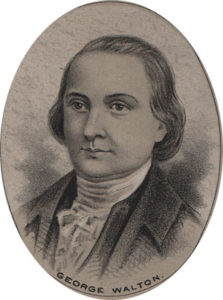Pura Belpré (born Cidra, Puerto Rico, 1899; died New York, New York, July 1, 1982) was a librarian and writer. She preserved and shared works by Latino writers. One of her most famous works was Juan Bobo and the Queen’s Necklace: A Puerto Rican Folk Tale. The American Library Association and REFORMA established the Pura Belpré Award in her honor. The award recognizes Latino writers and illustrations. Children can learn more by reading the Children’s Book Award Handbook by Diana F. Marks. Children could also read Planting Stories: The Life of Librarian and Storyteller Pura Belpré, written by Anika Aldamuy Denise and illustrated by Paola Escobar. The book received the 2020 Pura Belpré Author Honor Award.

A Pcoketful of Cricket
Rebecca Caudill (born Cumberland, Kentucky, 1899; died Urbana, Illinois, October 2, 1985) wrote more than 20 books for children. Her book Tree of Freedom was a 1950 Newbery Honor Book. She also wrote A Pocketful of Cricket. The illustrator, Evaline Ness, received a 1965 Caldecott Honor Award for her illustrations. The state of Illinois, where she lived for many years, created the Rebecca Caudill Young Reader’s Book Award in her honor. Every year the school children of Illinois vote for their favorite new book. Children could learn more about her at: Rebecca Caudill.
Jascha Heifitz (born Vilna, Lithuania, 1901; died Los Angeles, California, December 10, 1987) was a violin virtuoso. He started to play at age three and was performing at age six. At age thirteen he played in Berlin and found international fame. During the Russian Revolution he escaped to the United States, where he became a citizen in 1925. He recorded many great pieces and arrangements. Because of his technical skills, he was often the first person to play new pieces by present-day composers.
James Joyce (born Dublin, Ireland, 1882; died Zurich, Switzerland, January 13, 1941) was a writer. One of his most famous works is A Portrait of the Artist as a Young Man. Older children can read some of his works at: Project Gutenberg.
Lin Oliver (born Los Angeles, California, 1947) is a television producer and author of at least 50 children’s books. She co-writes the Hank Zipzer books with Henry Winkler. Children can learn more at: Lin Oliver.
Judith Viorst (born Newark, New Jersey, 1931) writes for both children and adults. She is also known for her poetry. One of her books is Alexander and the Terrible, Horrible, No Good, Very Bad Day. Another of her books is The Tenth Good Thing about Barney.





 George Walton died in Augusta, Georgia, on February 2, 1804. He was born near Farmville, Virginia, 1741, but his exact birth date is unknown. Representing Georgia, he signed the Declaration of Independence. He fought for his state militia during the Revolutionary War and was caught by the British in late 1778. He was imprisoned until September 1779, when he was exchanged for a British officer. After the war, he served as Georgia’s governor, a United States senator, and the chief justice of Georgia’s highest court. Children could learn more at:
George Walton died in Augusta, Georgia, on February 2, 1804. He was born near Farmville, Virginia, 1741, but his exact birth date is unknown. Representing Georgia, he signed the Declaration of Independence. He fought for his state militia during the Revolutionary War and was caught by the British in late 1778. He was imprisoned until September 1779, when he was exchanged for a British officer. After the war, he served as Georgia’s governor, a United States senator, and the chief justice of Georgia’s highest court. Children could learn more at: 
